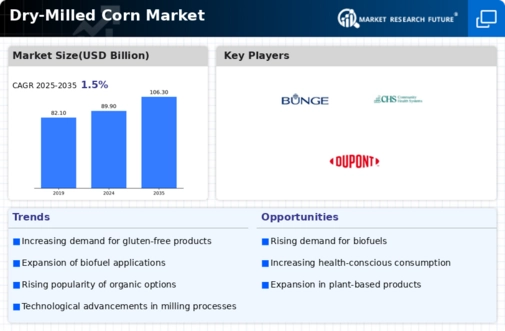Growth in Animal Feed Production
The livestock sector continues to expand, leading to a significant increase in the demand for animal feed, which heavily relies on dry-milled corn. In 2025, it is estimated that around 50 percent of dry-milled corn production is directed towards animal feed, particularly for poultry and swine. This trend is influenced by rising meat consumption and the need for high-quality feed ingredients. The Dry-Milled Corn Market is thus positioned to benefit from this growth, as feed manufacturers seek reliable sources of corn to meet their production needs. Additionally, the increasing focus on animal nutrition and health may drive innovations in feed formulations, further enhancing the value of dry-milled corn. The synergy between livestock production and corn milling indicates a promising outlook for stakeholders in the dry-milled corn market.
Rising Demand for Ethanol Production
The increasing demand for renewable energy sources has led to a notable rise in ethanol production, which utilizes dry-milled corn as a primary feedstock. In 2025, the ethanol industry is projected to consume approximately 40 percent of the total dry-milled corn output. This trend is driven by government policies promoting biofuels and the need for sustainable energy solutions. As a result, the Dry-Milled Corn Market is experiencing heightened demand, which may lead to increased prices and investment in milling technologies. Furthermore, the expansion of ethanol plants could stimulate local economies, creating jobs and enhancing agricultural productivity. The interplay between energy policies and agricultural outputs suggests a robust future for the dry-milled corn sector, as it aligns with global efforts to reduce carbon emissions and transition to cleaner energy sources.
Expansion of Food Processing Industries
The food processing sector is witnessing substantial growth, which is positively impacting the Dry-Milled Corn Market. As consumer preferences shift towards convenience foods, the demand for corn-based ingredients, such as cornmeal and corn flour, is on the rise. In 2025, the processed food market is expected to account for a significant portion of dry-milled corn consumption, driven by the increasing popularity of gluten-free and organic products. This trend suggests that food manufacturers are increasingly incorporating dry-milled corn into their products to cater to health-conscious consumers. Moreover, the expansion of snack food production, which often utilizes corn as a key ingredient, further underscores the potential for growth in the dry-milled corn sector. The interplay between food trends and corn milling indicates a dynamic market landscape.
Increased Focus on Sustainable Practices
Sustainability has become a pivotal concern within the agricultural sector, influencing the Dry-Milled Corn Market. As consumers and businesses alike prioritize environmentally friendly practices, there is a growing emphasis on sustainable farming and milling methods. In 2025, it is expected that a significant portion of dry-milled corn producers will adopt practices aimed at reducing their carbon footprint, such as precision agriculture and waste reduction strategies. This shift not only aligns with consumer preferences but also enhances the marketability of dry-milled corn products. Additionally, the potential for certification programs focusing on sustainability may provide a competitive edge for producers. The commitment to sustainable practices indicates a transformative phase for the dry-milled corn market, as it adapts to evolving consumer expectations and regulatory frameworks.
Technological Innovations in Milling Processes
Advancements in milling technology are transforming the Dry-Milled Corn Market, enhancing efficiency and product quality. Innovations such as precision milling and automated systems are enabling producers to optimize their operations, resulting in higher yields and reduced waste. In 2025, it is anticipated that these technological improvements will lead to a 15 percent increase in milling efficiency, allowing for better utilization of raw materials. Furthermore, the integration of data analytics and machine learning in milling operations may provide insights into production processes, enabling continuous improvement. As a result, stakeholders in the dry-milled corn market are likely to experience enhanced profitability and competitiveness. The ongoing evolution of milling technologies suggests a forward-looking approach to addressing market demands and sustainability challenges.

















Leave a Comment